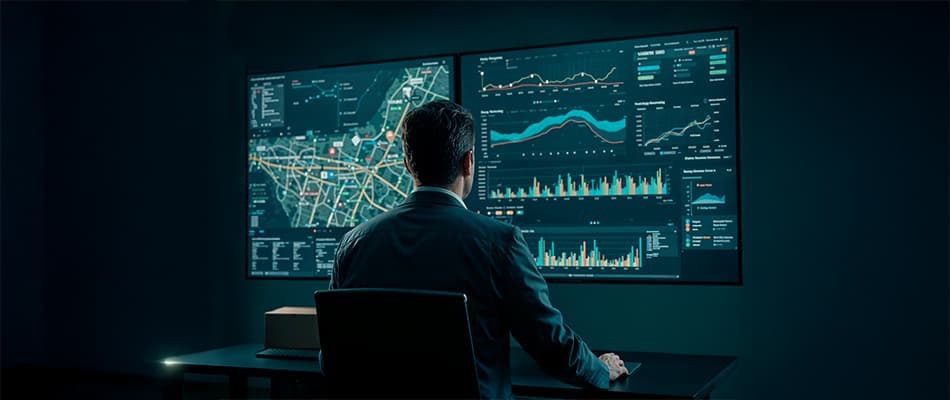Top 40 Project Manager Interview Questions and Answers
A Project Manager is a professional responsible for planning and managing projects to ensure timely completion within budget and with high standards. They coordinate tasks, manage teams, and communicate with stakeholders to achieve project goals efficiently and effectively. But everything is a step-by-step process, to be able to do these tasks, you must first get a job as a project manager. For that, you may have to clear a personal interview round, where your knowledge, confidence and skills in this field will be monitored. You must have a wide understanding of project management to make an impression on the interviewer. Therefore, to help you with it, we have prepared 40 questions and answers for project manager interview. These questions cover various topics, from technical skills and methodologies to soft skills and crisis management. By practising these questions, students can work on their responses, making them more concise and impactful during interviews.
Read the article to learn about these 40 project manager interview questions, the in-demand job profiles in project management and more!
Project Manager Interview Questions with Answers
These interview questions and answers provide the candidates with a complete understanding of common interview queries, helping them prepare effectively. By reviewing these questions and answers, candidates can enhance their confidence and improve their chances of securing a project management role. Here is a list of 40 Project Manager interview questions and answers. Check the QNAs to build your foundation in the field of project management.
Question No 1. Can you describe a project you have managed from conception to launch?
Answer: I managed a mobile application designed to streamline team collaboration from its initial concept to its successful launch. I began by conducting market research and collecting customer feedback to identify key points. Next, I defined user personas and created a blueprint for the project, prioritising essential features. Throughout development, I used Agile methodologies, conducting regular sprints and iterations. Post-launch, I closely monitored user engagement and feedback to make continuous improvements.
Question No 2. How do you prioritise features for a project blueprint?
Answer: I prioritise features based on customer feedback, business goals, and technical workability. I use frameworks like the MoSCoW method to categorise features into must-haves, should-haves, could-haves, and won’t-haves. Additionally, I consider each feature’s potential ROI and impact on user experience. Stakeholder input is also important, so I ensure their voices are heard during prioritisation discussions. Finally, I maintain flexibility to adjust priorities based on changing market conditions and new insights.
Question No 3. What methods do you use to collect customer feedback?
Answer: I use various methods to collect customer feedback, including surveys, user interviews, and focus groups. I also use feedback forms and in-app feedback mechanisms. Additionally, I analyse customer reviews on app stores and social media channels. I regularly conduct usability testing sessions to observe real-time user interactions with the project. Combining these qualitative and quantitative approaches ensures a comprehensive understanding of customer needs and pain points.
Question No 4. How do you define the success of a project?
Answer: Defining a project’s success includes measuring quantitative and qualitative metrics. Key performance indicators (KPIs) such as revenue growth, user engagement, and customer retention rates are also important. Customer satisfaction and feedback also play a significant role, providing insights into the project’s usability and value. Market share and competitive positioning further indicate the project’s success in the industry. Ultimately, a successful project meets or exceeds its strategic objectives and delivers value to the company and its customers.
Question No 5. Can you give an example of a time you had to say no to a stakeholder?
Answer: Once, a stakeholder requested a new feature that did not align with our project strategy and would have diverted resources from higher-priority tasks. I carefully explained the rationale behind our current priorities and the potential negative impact of changing course. I ensured the stakeholders understood the broader context by providing data and user feedback to support my decision. I also offered alternative solutions to address their underlying concerns. Ultimately, this approach maintained stakeholder trust while keeping the project on track.
Question No 6. How do you balance technical debt with new feature development?
Answer: Balancing technical debt with new feature development requires ongoing assessment and prioritisation. I regularly collaborate with the development team to identify and document technical debt. By incorporating technical debt into the project blueprint, we allot time for necessary refactoring and maintenance alongside new feature development. I ensure that critical technical debt is addressed on time to prevent long-term negative impacts. This balance is achieved through transparent communication and a shared understanding of the project’s long-term vision.
Question No 7. Describe your experience with Agile and Scrum methodologies.
Answer: I have extensive experience using Agile and Scrum methodologies to manage project development. Agile breaks project into small, manageable sprints, allowing regular progress and feedback. As a Scrum Master, I do daily stand-ups, sprint planning, and retrospectives to ensure the team stays on track and addresses any blockers promptly. This approach promotes continuous improvement and adaptability to changing requirements. My experience has shown that Agile and Scrum improve collaboration, transparency, and efficient delivery of high-quality projects.
Question No 8. How do you handle conflicting priorities from different stakeholders?
Answer: When facing conflicting priorities from different stakeholders, I start by actively listening to understand each stakeholder’s perspective and underlying needs. I then use data and business objectives to evaluate and compare the impact of each priority. I have discussions to align on shared goals and compromises through open and transparent communication. I will ask senior leadership to make final decisions based on strategic direction if necessary. Maintaining empathy and focusing on the overall project vision helps resolve conflicts effectively.
Question No 9. What is your approach to competitive analysis?
Answer: My approach to competitive analysis includes identifying and evaluating key competitors in the market. I conduct a SWOT analysis (Strengths, Weaknesses, Opportunities, Threats) for each competitor to understand their positioning and strategies. Regularly monitoring competitors’ project updates, pricing strategies, and customer feedback provides valuable insights. Additionally, I use tools like market reports, industry blogs, and customer surveys to collect comprehensive data. This analysis helps inform our project strategy and identify areas for differentiation and improvement.
Question No 10. How do you validate a project idea before development?
Answer: To validate a project idea before development, I conduct thorough market research to assess demand and identify target customers. I create a minimum viable project (MVP) or prototype to test core functionalities with a small group of users. Collecting feedback through surveys, interviews, and usability tests helps refine the idea. Additionally, I analyse metrics such as engagement rates, conversion rates, and user feedback to gauge interest and potential success. This validation process ensures that we invest in creating a project that meets real user needs.
Question No 11. Can you describe a time you had to pivot a project strategy?
Answer: We initially launched a tool aimed at freelancers, but early feedback revealed a stronger demand among small businesses. After analysing user feedback and market demands, we decided to pivot our strategy to provide this to a broader audience. This included redesigning certain features and adjusting our marketing approach. The pivot led to increased user adoption and higher engagement rates. It highlighted the importance of being adaptable and responsive to user needs.
Question No 12. How do you ensure alignment between the project team and other departments?
Answer: I ensure alignment by creating open communication and collaboration across departments through regular cross-functional meetings. Clear documentation and shared project management tools keep everyone on the same page. I also involve stakeholders from marketing, sales, and customer support early in the project development process. This ensures their insights and requirements are integrated into the project strategy. Regular updates and feedback loops help maintain alignment throughout the project lifecycle.
Question No 13. What tools do you use for project management and why?
Answer: Due to its strong Agile features, I use Jira to track development tasks and manage sprints. Trello or Asana helps visualise workflows and collaborate on tasks across teams. For road mapping, I prefer tools like Aha! or Project Plan, which allow for easy updates and sharing of the project vision. Slack is essential for real-time communication and collaboration. Tools like Google Analytics and Hotjar also provide valuable insights into user behaviour and project performance.
Question No 14. How do you handle a project that is underperforming?
Answer: First, I conduct a thorough analysis to identify the root causes of underperformance, including user feedback, usage data, and market conditions. I then reassess our project strategy and prioritise necessary improvements or feature adjustments. Engaging with customers to understand their pain points and collect actionable insights is essential. Implementing targeted changes and closely monitoring the impact helps address issues effectively. If necessary, I consider a more significant pivot or re-evaluation of the project’s value proposition.
Question No 15. Describe your experience with user personas and how you use them.
Answer: In my experience, creating user personas has been invaluable for understanding and empathising with our target audience. I collect customer interviews, surveys, and analytics data to create detailed profiles representing different user segments. These personas include demographic information, behaviours, motivations, and pain points, which help in engaging more targeted and relevant product features. I use these personas to guide decision-making during development, ensuring that the product aligns with user needs and expectations. This approach enhances user satisfaction and improves the overall effectiveness of our marketing and user engagement strategies.
Question No 16. What is your process for creating a project roadmap?
Answer: I start by defining clear project goals aligned with business objectives and customer needs. I collect input from stakeholders across departments to ensure a comprehensive perspective. Prioritising features and initiatives include balancing user feedback, market trends, and technical feasibility. I use road mapping tools to create a visual representation, outlining short-term and long-term plans. Regular reviews and updates to the roadmap ensure it remains relevant and adaptable to changing priorities and market conditions.
Question No 17. How do you handle a situation where the development team misses a deadline?
Answer: First, I assess the reasons behind the missed deadline, ensuring I understand the development team’s challenges. Open communication is essential to address any issues and identify potential solutions. I work with the team to re-evaluate the timeline and adjust the project plan as required. Transparent communication with stakeholders about the delay and revised timelines helps manage expectations. Implementing lessons learned from the experience helps prevent similar issues in future projects.
Question No 18. Can you give an example of a project metric you tracked and why?
Answer: I tracked the user engagement rate for a mobile app to understand how well it retained users over time. This metric evaluated the app’s long-term value and user satisfaction. By analysing engagement rates, we identified points where users dropped off and made targeted improvements to the ongoing process and core features. This data-driven approach led to increased user retention and overall engagement.
Question No 19. How do you approach setting and managing a project budget?
Answer: Setting a project budget includes a thorough analysis of development costs, marketing expenses, and expected revenue. I collaborate with finance and other departments to ensure a realistic and comprehensive budget. Regularly tracking expenses against the budget helps identify variances and promptly address any financial issues. Prioritising spending on high-impact areas ensures efficient use of resources. Regular reviews and adjustments to the budget keep it aligned with the project’s needs and business goals.
Question No 21. What is your experience with A/B testing?
Answer: A/B testing has been a main part of my strategy for optimising project features and user interfaces. By comparing two versions of a feature with different user groups, we can identify which version performs better based on predefined metrics. I’ve used A/B testing to test everything from UI changes to new feature implementations. This data-driven approach ensures that decisions are backed by real user behaviour and preferences. Continuous A/B testing helps make incremental improvements and achieve better user satisfaction and engagement.
Question No 22. Describe a time when you had to manage a project crisis.
Answer: During a major project update, we faced a critical bug that caused significant user disruptions. I immediately called a cross-functional team to diagnose and address the issue. We communicated transparently with affected users, providing regular updates and offering temporary solutions. The team worked tirelessly to fix the error, and we implemented additional testing protocols to prevent future crises. This experience made me feel the importance of rapid response and clear communication during project emergencies.
Question No 23. How do you ensure the project vision is clearly communicated to the team?
Answer: I start by developing a concise and compelling project vision statement that aligns with our business goals. This vision is shared through detailed documentation and presentations during team meetings. I ensure continuous alignment by holding regular check-ins and progress reviews. Visual aids, such as roadmaps and diagrams, help illustrate the vision and strategic direction. Open dialogue and feedback loops keep the team engaged and informed.
Question No 24. What strategies do you use to onboard new users to a project?
Answer: I focus on creating an intuitive, user-friendly onboarding experience that guides users through key features and benefits. Interactive tutorials, in-app guides, and emails are essential components of the onboarding process. Personalisation and targeted messaging help address specific user needs and preferences. Collecting feedback from new users allows for continuous improvement of the onboarding experience. Metrics like user activation and engagement rates are tracked to measure onboarding success.
Question No 25. How do you stay updated with the latest updates in project management?
Answer: I regularly read industry blogs, follow thought leaders on social media, and subscribe to relevant newsletters. Attending webinars, conferences, and workshops helps me stay updated about new methodologies and tools. Participating in professional networks and online communities improves knowledge sharing and peer learning. Continuous learning through online courses and certifications ensures I stay current with best practices. Implementing and experimenting with new trends in my work helps keep my skills sharp and relevant.
Question No 26. Describe a time you had to make a data-driven decision.
Answer: When user engagement on a key feature declined, I conducted a thorough analysis using analytics tools to understand user behaviour. The data revealed that users were dropping off due to a complicated workflow. We simplified the feature’s interface and streamlined the process based on this insight. Post-implementation metrics showed a significant increase in user engagement and satisfaction. This experience strengthens the value of data in guiding project decisions.
Question No 27. How do you collect and prioritise customer requirements?
Answer: I collect customer requirements using several surveys, user interviews, and feedback forms. Analysing support tickets and user behaviour data also provides valuable insights. I prioritise these requirements based on factors like impact, workability, and alignment with business goals. Tools like the MoSCoW method and the Kano model help systematically categorise and prioritise features. Regularly revisiting and adjusting priorities ensures they remain relevant as the project changes.
Question No 28. What is your approach to working with remote teams?
Answer: Clear and frequent communication is key to working with remote teams. It is done through mediums like Slack, Zoom, and project management platforms. Setting clear expectations and goals ensures everyone is aligned and accountable. I will provide a collaborative environment through regular virtual meetings and team-building activities. Utilising time zone differences to our advantage, we maintain projectivity around the clock. Continuous feedback and open dialogue help address any challenges and keep the team motivated and cohesive.
Question No 29. How do you manage stakeholder expectations?
Answer: Setting clear, realistic goals and communicating them transparently is essential. I provide regular updates on progress, milestones, and any changes in the plan. Managing expectations includes actively listening to stakeholders’ concerns and addressing them promptly. I ensure stakeholders understand the reasoning behind decisions and involved trade-offs. Building trust through consistent, honest communication helps maintain positive relationships and manage expectations effectively.
Question No 30. How do you handle changes in project scope and ensure alignment with stakeholders?
Answer: Handling changes in project scope includes a systematic approach to ensure alignment with stakeholders. Firstly, I assess the impact of the proposed changes on the project timeline, budget, and resources. I then communicate these potential impacts clearly to all relevant stakeholders, ensuring they understand the implications. To maintain alignment, I seek formal approval for the changes from key stakeholders and update project documentation accordingly. Finally, I adjust the project plan to reflect the approved changes and ensure that the team is informed and aligned with the new scope.
Question No 31. How do you handle feedback that you disagree with?
Answer: I listen to the feedback carefully to understand the underlying concerns and perspectives. I ask clarifying questions to ensure I grasp the full context. If I disagree, I provide a respectful and reasoned response, explaining my viewpoint and the data or reason behind it. I remain open to further discussion and consider any valid points that may arise. Ultimately, I seek a balanced approach that addresses the feedback while aligning with the project’s goals and strategy.
Question No 32. What is your process for conducting market research?
Answer: My process for conducting market research starts with defining clear objectives and identifying target audiences. I use primary research methods like surveys and interviews and secondary research like industry reports and competitor analysis. Analysing this data helps identify market trends, customer needs, and potential gaps in the market. I also use tools like SWOT analysis to assess strengths, weaknesses, opportunities, and threats. The insights gained guide strategic decision-making and project development.
Question No 33. Describe your experience with project lifecycle management.
Answer: My experience with project lifecycle management includes managing projects from start to finish. This includes market research, defining project requirements, development, launch, and post-launch support. I use metrics to track project performance and make data-driven decisions for improvements or pivots. Regular reviews and updates ensure the project remains competitive and meets customer needs. Successfully managing the lifecycle of several projects has improved my ability to adapt strategies as market conditions change.
Question No 34. What is your approach to developing a go-to-market strategy?
Answer: Developing a go-to-market strategy begins with thorough market research and an understanding of customer segments. I define clear value propositions and positioning statements that differentiate the project. Collaborating with marketing, sales, and customer support teams, I create a cohesive launch plan that includes promotional tactics, pricing strategies, and distribution channels. A phased rollout allows for feedback collection and improvements. Post-launch, I continuously monitor performance and adjust strategies based on real-time data.
Question No 35. How do you ensure project quality?
Answer: Ensuring project quality includes implementing several testing protocols throughout development. I work closely with QA teams to conduct unit, integration, and user acceptance testing. Gathering feedback from beta testers helps identify and resolve issues early. Regular code reviews and adherence to best practices in development also contribute to maintaining high standards. Continuous monitoring and updates post-launch ensure ongoing quality and reliability.
Question No 36. How do you handle scope creep in a project?
Answer: I use clear project requirements and objectives from the outset to handle scope creep, ensuring all stakeholders are aligned. Any proposed changes are used against the project’s goals, and I assess their impact on resources and deliverables. I use change management processes to approve modifications. Regular communication with stakeholders helps me manage expectations and prevent unauthorised changes. Prioritising tasks and maintaining flexibility ensures the project stays on track.
Question No 37. What is your experience with building and managing cross-functional teams?
Answer: Building and managing cross-functional teams includes selecting members with complementary skills and creating a collaborative environment. I emphasise clear communication, setting common goals, and ensuring everyone understands their roles and responsibilities. Regular meetings and updates keep the team aligned and engaged. I encourage knowledge sharing and diverse perspectives to drive innovation. Managing conflicts and promoting a culture of mutual respect contribute to the team’s success.
Question No 38. How do you manage project documentation?
Answer: Managing project documentation includes creating comprehensive and accessible resources for both internal and external stakeholders. I use collaborative tools like Confluence or Google Docs to maintain up-to-date documents, including user manuals, technical specifications, and FAQs. Regular reviews and updates ensure the documentation reflects the latest project features and changes. I also collect feedback from users and team members to continuously improve the content.
Question No 39. Can you describe a time you had to work with a difficult team member?
Answer: I once worked with a team member who was resistant to feedback and often missed deadlines. I approached the situation with a candid, private conversation to understand their perspectives and challenges. We used clear expectations and created a structured plan with regular check-ins. Providing support and resources, I encouraged open communication and collaboration. Over time, the team member’s performance improved, and we met our project goals.
Question No 40. How do you incorporate customer feedback into the product development cycle?
Answer: Incorporating customer feedback into the product development cycle includes several steps. First, I collect feedback through various channels such as surveys, user interviews, and customer support interactions. Then, I analyse the feedback to identify common themes and prioritise issues based on their impact on the user experience and business goals. I work closely with the development team to integrate the feedback into our product roadmap and ensure necessary changes are made. Finally, I communicate updates to customers, showing them how their input has influenced the product, and continue to seek their feedback for ongoing improvement.

In-demand Project Management Job Profiles
The demand for Project Managers is rising due to the increasing complexity and scale of projects across various industries. Companies like Samaha Consulting and Siemens Healthineers actively seek fresh talent, providing opportunities to manage project documentation, coordinate meetings, and track project progress. Essential skills for these roles include proficiency in project management software (e.g., MS Project, Asana), strong organisational abilities, and excellent communication skills. Additionally, roles like Junior Project Coordinator and Project Management Graduate provide hands-on experience in coordinating project activities, preparing project proposals, and ensuring effective stakeholder communication. These positions serve as a strong foundation for career growth in project management, with opportunities to work in diverse industries such as IT services, consulting, and healthcare. Different positions in the field of Project Management are:
- Project Administrator
- Junior Project Management Coordinator
- Project Manager
- Technical Project Manager
- Project Coordinator
Check detailed Project Manager Salary in South Africa here
Enrol in Digital Regenesys Project Management Course
The journey to becoming a project manager is only easy with essential skills and knowledge. You must have a proper understanding of industry-standard tools and methodologies to see yourself as a successful project manager. You can join different boot camps and online courses to acquire these skills and knowledge. One such course is Digital Regenesys’ Project Management Course. The course offers hands-on experience with industry-standard tools such as Microsoft Project Plan (MPP) and includes advanced methodologies like Agile and Scrum. You will gain practical knowledge and learn industry best practices from experienced professionals. After completing this course, you will receive an internationally recognised certification.
These 40 Project Manager interview questions and answers guide are essential for students preparing for interviews. It covers essential topics from technical skills and methodologies to crisis management and stakeholder communication. By practising these questions, students can work on their responses, ensuring they are correct and impactful. The Digital Regenesys Project Management Course also equips students with critical skills required for today’s competitive business landscape. With hands-on experience, industry-standard tools, and expert insights, students can enhance their project management capabilities, leading to improved career prospects and business success.
FAQs on Project Manager Interview Questions and Answers
What is the role of a project manager?
A project manager manages the planning, execution, and completion of projects, ensuring they meet objectives, timelines, and budgets.
What are the key phases of a project lifecycle?
The key phases are initiation, planning, execution, monitoring & controlling, and closure.
What are the five pillars of a project manager?
The five pillars of a project manager are scope, time, cost, quantity and risk.
What are the 5 C’s of project management?
The 5 C’s of project management are Complexity, Criticality, Compliance, Culture, and Compassion.
What tools are commonly used for project management?
Popular tools include Jira, Trello, Asana, Microsoft Project Plan, and Confluence.
What are Key Performance Indicators (KPIs) in project management?
KPIs are metrics used to evaluate project performance, such as budget variance, schedule variance, quality metrics, and stakeholder satisfaction.
Where can I get project manager interview questions and answers pdf?
You can find senior project manager interview questions and answers pdf on various online platforms such as job boards, project management websites, and professional networking sites.
Recommended Posts












